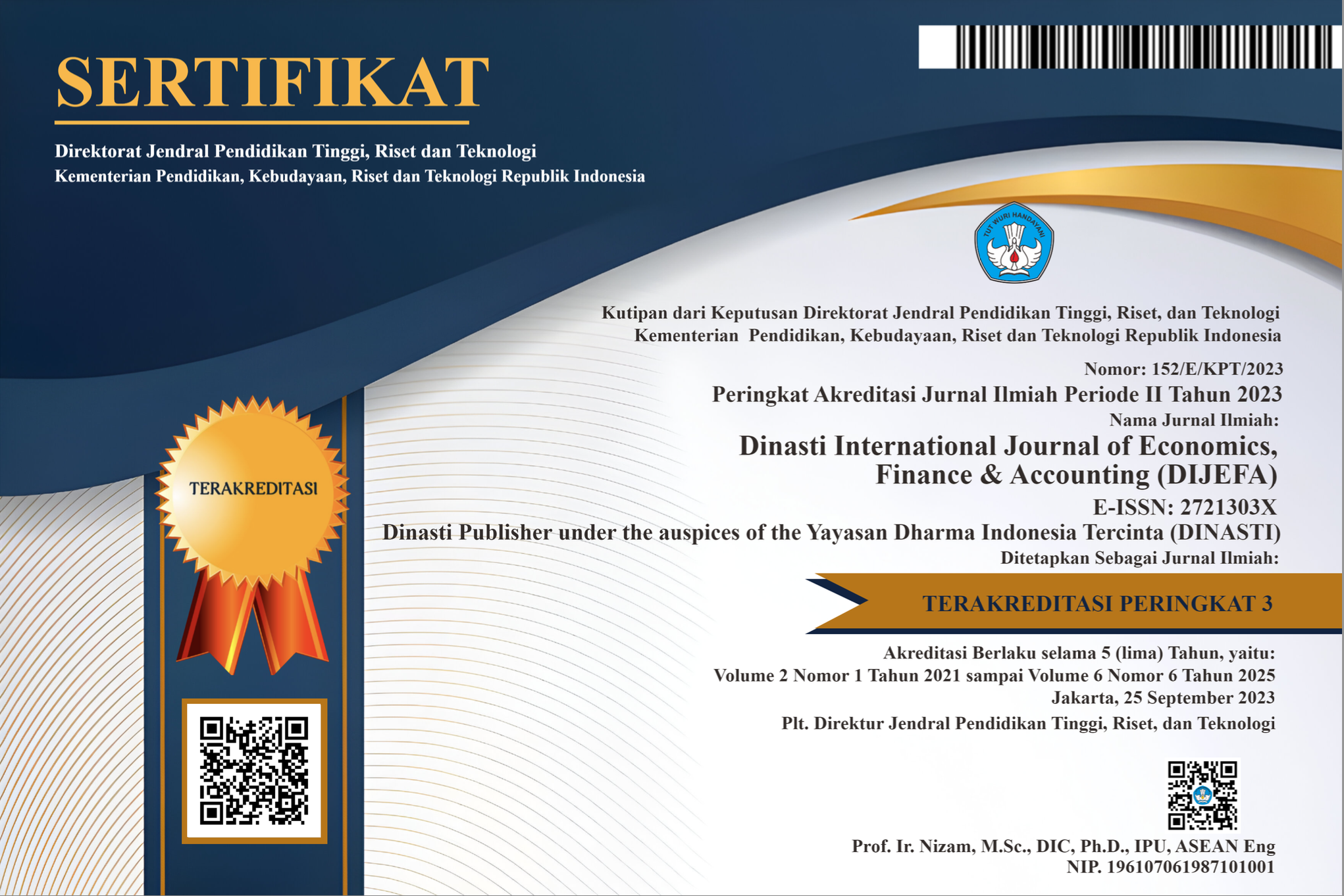Determinants That Influence Financial Sustainability Through Profitability
DOI:
https://doi.org/10.38035/dijefa.v5i4.3443Keywords:
LDR, NPL, BOPO, CAR, FSRAbstract
This research aims to determine whether LDR, NPL, BOPO, and CAR have a direct effect on FSR through ROA in banks listed on the Indonesia Stock Exchange. The sample was selected using purposive sampling with a total sample of 40 banks. The research data was tested using path analysis. The results of the direct analysis show that LDR does not affect FSR, while NPL, BOPO, and CAR have a negative and significant effect on FSR. Additionally, ROA has a positive and significant effect on FSR. Furthermore, LDR and CAR do not affect ROA, whereas NPL has a positive and significant effect, and BOPO has a significant negative effect on ROA. The results of the indirect analysis show that LDR, NPL, and CAR do not affect FSR through ROA, whereas BOPO has a significant negative effect on FSR through ROA.
References
Adhim, C. (2019). Pengaruh Resiko Kredit, Resiko Likuiditas, Efisiensi Manajemen terhadap Profitabilitas: Studi pada Perbankan yang Terdaftar di Bursa Efek Indonesia. Cendekia: Jurnal Pendidikan Dan Pembelajaran, 13(2), 141–152. https://doi.org/10.30957/cendekia.v13i2.604
Alifiana, M. A., Puteri, A. N., & Kuncoro, M. T. (2023). Faktor-Faktor Yang Berdampak Pada Financial Sustainability Ratio Di Bank BUMN Periode 2015-2022. Master: Jurnal Manajemen Dan Bisnis Terapan, 3(2), 107–117.
Alim, M., & Sina, D. I. (2020). Pengaruh Capital Adequacy Ratio, Non Performing Financing Dan Laba Bersihterhadap Financial Sustainability Ratio (Pada Perusahaan Perbankan Syariah Yang Ada Di Indonesia Periode 2014-2018). Balance Vocation Accounting Journal, 4(1), 28. https://doi.org/10.31000/bvaj.v4i1.2701
Almaida, Y., Ruhadi, R., & Djuwarsa, T. (2023). Analisis Faktor Spesifik Bank dan Corporate Governance terhadap Financial Sustainability BUS di Indonesia. Journal of Applied Islamic Economics and Finance, 3(3), 541–553. https://doi.org/10.35313/jaief.v3i3.5343
Asriyana, N. A., Purbayati, R., & Barnas, B. (2022). Determinan Capital Adequacy Ratio Sebagai Indikator Ketahanan Modal Pada Bank Umum Syariah di Indonesia. Indonesian Journal of Economics and Management, 2(2), 277–295. https://doi.org/10.35313/ijem.v2i2.3697
Avrita, R. D., & Pangestuti, I. R. D. (2016). Analisis Pengaruh CAR, NPL, LDR, NIM, dan BOPO Terhadap Profitabilitas Bank. Journal Ofmanagement, 5(2), 1–13. https://ejournal3.undip.ac.id/index.php/djom/article/view/13964
Ayuningtyas, R. D., Wati, R., & Safa’ah, F. (2018). Sustainability of sharia rural bank in Central Java. Jurnal Ekonomi & Keuangan Islam, 4(2), 59–66. https://doi.org/10.20885/jeki.vol4.iss2.art1
Brigham, E. F. (2019). Dasar-dasar Manajemen Keuangan (2nd ed.). Salemba Empat.
Dianita, M., & Phety, D. T. O. (2021). “The Effect Of Return On Assets (ROA) And Return On Equity (ROE) Towards Changes In Share Prices.” Turkish Journal of Computer and Mathematics Education (TURCOMAT), 12(8), 651–657. https://doi.org/https://doi.org/10.17762/turcomat.v12i8.2870
Fauziah, R. S., & Fadhilah, N. H. K. (2022). The Impact of Credit Risk on The Profitability With Characteristics Bank as Control Variables. Jurnal Akuntansi, 9(2), 145–158. https://doi.org/10.30656/jak.v9i2.4346
Hartadinata, O. S., & Varihah, E. (2023). Ada Apa Dengan Bank Jatim dan Keuangan Berkelanjutan di Masa Pandemi? Jurnal Akuntansi & Keuangan Unja, 7(1), 20–30. https://doi.org/10.22437/jaku.v7i1.16664
Hasan, M. S. A., Manurung, A. H., & Usman, B. (2020). Determinants of Bank Profitability with Size as Moderating Variable. Journal of Applied Finance & Banking, 10(1), 1792–6599.
Julius R. Latumaerissa. (2017). Bank dan Lembaga Keuangan Lain. Mitra Wacana Media.
Latuamury, J., Cakranegara, P. A., Butar-butar, R. S., & Anantadjaya, S. P. D. (2023). Profitability Factors Using the Loans to Deposits Ratio as a Moderating Variable. SEIKO: Journal of Management & Business, 6(1), 875–886. https://doi.org/10.37531/sejaman.vxix.436
MacHdar, N. M. (2020). Financial inclusion, financial stability and sustainability in the banking sector: The case of Indonesia. International Journal of Economics and Business Administration, 8(1), 193–202. https://doi.org/10.35808/ijeba/418
Majumder, M. T. H., & Li, X. (2018). Bank risk and performance in an emerging market setting: the case of Bangladesh. Journal of Economics, Finance and Administrative Science, 23(46), 199–229. https://doi.org/10.1108/JEFAS-07-2017-0084
Matuszak, ?., & Ró?a?ska, E. (2020). Online corporate social responsibility (CSR) disclosure in the banking industry: evidence from Poland. Social Responsibility Journal, 16(8), 1191–1214. https://doi.org/10.1108/SRJ-11-2018-0303
Meher, K., & Getaneh, H. (2019). Impact of determinants of the financial distress on financial sustainability of ethiopian commercial banks. Banks and Bank Systems, 14(3), 187–201. https://doi.org/10.21511/bbs.14(3).2019.16
Miranti, T., & Oktaviana, U. K. (2022). Effect of Capital Structure on Financial Sustainability of Sharia Public Financing Bank (BPRS). Ad-Deenar: Jurnal Ekonomi Dan Bisnis Islam, 6(01), 137. https://doi.org/10.30868/ad.v6i01.2301
Munandar, A., & Aravik, H. (2022). Pengaruh CAMEL terhadap Financial Sustainability Ratio pada Bank Umum Syariah Periode Juni 2014 - Februari 2022. Jurnal Pemikiran Dan Pengembangan Ekonomi Syariah, 8(1), 49–58.
Nizam, H. W., Sahetapy, R. D., & Supro, C. K. (2023). Interest Rate and Sustainability of Basler Kantonalbank ( BKB ) in Basel , Switzerland. Journal of Finance and Accounting, 7(7), 1–11. https://doi.org/https://doi.org/10.53819/81018102t5235
Notoatmojo, M. I., & Rahmawaty, A. (2016). Analisis Faktor-Faktor yang Memengaruhi Financial Sustainability Ratio pada Bank Umum Syariah di Indonesia Periode 2010-2014. Jurnal Ekonomi Syariah, 4(1), 20–42.
Nurhikmah, S., & Rahim, R. (2021). Pengaruh Faktor Keuangan dan Non Keuangan terhadap Financial Sustainability Ratio Perbankan. Journal of Management and Business Review, 18(1), 25–47.
Nuryanto, U. W., Salam, A. F., Sari, R. P., & Suleman, D. (2020). Pengaruh Rasio Kecukupan Modal, Likuiditas, Risiko Kredit dan Efisiensi Biaya Terhadap Profitabilitas Pada Bank Go Public. Moneter - Jurnal Akuntansi Dan Keuangan, 7(1), 1–9. https://doi.org/10.31294/moneter.v7i1.6777
OJK. (2022). Roadmap Keuangan Berkelanjutan di Indonesia 2015-2019. In Otoritas Jasa Keuangan.
Oliveira, V. B., & Raposo, C. (2020). How did regulation and market discipline influence banking distress in Europe?: Lessons from the global financial crisis. Studies in Economics and Finance, 37(1), 160–198. https://doi.org/10.1108/SEF-03-2019-0123
Panta, B. (2018). Non-Performing Loans & Bank Profitability: Study of Joint Venture Banks in Nepal. International Journal of Sciences: Basic and Applied Research (IJSBAR) International Journal of Sciences: Basic and Applied Research, 42(1), 151–165. http://gssrr.org/index.php?journal=JournalOfBasicAndApplied
Permatasari, V. D., & Utiyati, S. (2018). Pengaruh NPL, CAR, BOPO dan LDR terhadap Profitabilitas pada Perusahaan Perbankan. Jurnal Ilmu Dan Riset Manajemen, 7(7), 1–19.
Pungus, C. N., Maramis, J. B., & Karuntu, M. M. (2024). Pengaruh Return On Asset, Non-Performing Loan, Loan To Deposit Ratio Terhadap Financial Sustainability Dengan Nilai Perusahaan Sebagai Variabel Intervening Pada Perusahaan Perbankan Yang Go Public. Jurnal EMBA, 12(01), 295–306.
Rustam, A., & Adil, M. (2022). Financial Sustainability Ratio and Aspects That Affect It. Jurnal Akuntansi, 26(1), 144.
Sanfa, A. S., & Ida, I. (2023). Financial Ratios Predictors of Financial Sustainability of the Banking Sector in Indonesia. Financial: Jurnal Akuntansi, 9(1), 1–17. https://doi.org/10.37403/financial.v9i1.491
Santoso, A., & Sofiatun, S. (2022). Detection of Determinants of Bank Sustainability Performance. Jurnal Ekonomi LLDIKTI Wilayah 1 (JUKET), 2(2), 69–77. https://doi.org/10.54076/juket.v2i2.238
Sastrawan, R., Saputra, E., & Pratiwi, N. (2023). Determinan Profitabilitas Dengan Rasio Pinjaman Terhadap Simpanan Sebagai Variabel Moderasi. Jurnal Akuntansi Dan Keuangan, 11(1), 57. https://doi.org/10.29103/jak.v11i1.9772
Sugiyono, prof. dr. (2018). metode penelitian kuantitatif, kualitatif, dan R&D. ALFABETA, CV.
Sukmadewi, R. (2020). The Effect of Capital Adequacy Ratio, Loan to Deposit Ratio, Operating-Income Ratio, Non Performing Loans, Net Interest Margin on Banking Financial Performance. ECo-Buss, 2(2), 1–10. https://doi.org/10.32877/eb.v2i2.130
Sunaryo, D. (2020). The Effect Of Capital Adequacy Ratio (CAR), Net Interest Margin (NIM), Non-Performing Loan (NPL), and Loan To Deposit Ratio (LDR) Against Return On Asset (ROA) In General Banks In Southeast Asia 2012-2018. Ilomata International Journal of Management, 1(4), 149–158. https://doi.org/10.52728/ijjm.v1i4.110
Sutikno, H. T. (2022). Financial Performance and Financial Sustainability: The Role of Institutional Ownership as Moderating Variable. Journal of Economics, Finance And Management Studies, 05(04), 1165–1172. https://doi.org/10.47191/jefms/v5-i4-25
Ullah, M. A., Nath, S. D., & Biswas, M. R. (2020). Impact of bank-specific internal factors on the profitability of state-owned commercial banks in Bangladesh. Indian Journal of Commerce & Management Studies, XI(2), 24. https://doi.org/10.18843/ijcms/v11i2/03
Xu, L. (2015). Impacts of capital regulation and market discipline on capital ratio selection: Evidence from China. International Journal of Managerial Finance, 2(1), 1–28.
Yuhasril, Y. (2019). The Effect of Capital Adequacy Ratio (CAR), Non Performing Loan (NPL), Operational Efficiency (BOPO), Net Interest Margin (NIM), and Loan to Deposit Ratio (LDR), on Return on Assets (ROA). 166–176. https://doi.org/10.7176/RJFA
Zabolotnyy, S., & Wasilewski, M. (2019). The concept of financial sustainability measurement: A case of food companies from Northern Europe. Sustainability (Switzerland), 11(18), 1–16. https://doi.org/10.3390/su11185139
Zheng, C., Bhowmik, P. K., & Sarker, N. (2020). Industry-specific and macroeconomic determinants of non-performing loans: A comparative analysis of ARDL and VECM. Sustainability (Switzerland), 12(1), 1–17. https://doi.org/10.3390/su12010325
Downloads
Published
How to Cite
Issue
Section
License
Copyright (c) 2024 Chairul Adhim, Mulyati

This work is licensed under a Creative Commons Attribution 4.0 International License.
Authors who publish their manuscripts in this journal agree to the following conditions:
- The copyright on each article belongs to the author(s).
- The author acknowledges that the Dinasti International Journal of Economics, Finance & Accounting (DIJEFA) has the right to be the first to publish with a Creative Commons Attribution 4.0 International license (Attribution 4.0 International (CC BY 4.0).
- Authors can submit articles separately, arrange for the non-exclusive distribution of manuscripts that have been published in this journal into other versions (e.g., sent to the author's institutional repository, publication into books, etc.), by acknowledging that the manuscript has been published for the first time in the Dinasti International Journal of Economics, Finance & Accounting (DIJEFA).


























































